Coronavirus (COVID-19): modelling the epidemic (issue no.88)
Latest findings in modelling the COVID-19 epidemic in Scotland, both in terms of the spread of the disease through the population (epidemiological modelling) and of the demands it will place on the system, for example in terms of health care requirement.
Coronavirus (Covid-19): modelling the epidemic in Scotland (Issue No. 88)
Background
This is a report on the Scottish Government modelling of the spread and level of Covid-19 in Scotland. This updates the previous publication on modelling of Covid-19 in Scotland published on 27th January 2022. The estimates in this document help the Scottish Government, the health service and the wider public sector plan and put into place what is needed to keep us safe and treat people who have the virus.
This edition of the research findings focuses on the epidemic as a whole, looking at estimates of R, growth rate and incidence as well as local measures of change in the epidemic.
Key Points
- The reproduction rate R in Scotland is currently estimated as being between 0.6 and 0.9, as of 18th January 2022. The lower limit has decreased since last week.
- The daily growth rate for Scotland is currently estimated as between -8% and -1% as at 18th January. The upper limit has increased since last week.
- The number of new daily infections for Scotland is estimated as being between 146 and 270 as at 18th January, per 100,000 people.
- Average contacts from the most recent Panel A cohort of the Scottish Contact Survey (week ending 26th January) indicate an average of 4.7 contacts. This has increased by 13% compared to two weeks prior. In issue 87 we reported average contacts of 5.0 based on Panel B (for the week ending 19th January).
- Mean contacts have increased within the work and other setting (contacts outside home, school and work) by 45% and 13% respectively in the last two weeks. Contacts within the home have remained at a similar level over the same period.
- All age groups with the exception of those in the 30-39 age group reported an increase in contacts in the last two weeks. Increases were largely driven by contacts within the work setting for those under 70. Individuals 70 and over reported a rise in contacts within the other setting.
- The biggest increase in interactions between age groups is between those aged 18-29 with each other, where interactions have almost doubled in comparison to two weeks prior.
- Visits to another's home reported the biggest decrease, from approximately 47% to 43% while visits to a healthcare facility reported the largest increase, from 12% to 21% in the last two weeks.
- The number of people wearing a face covering where they have at least one contact outside of the home has increased in the last two weeks from 75% to 81%.
- Approximately 78% of individuals had taken at least one lateral flow test within the last 7 days, decreasing from 84% two weeks prior. Of those individuals who had taken a lateral flow within the last 7 days, 27% did not report their results.
- The future trajectory of infections, hospitalisations, hospital occupancy and deaths is highly uncertain; some Delta infections may also continue. We estimate that daily infections may be between 5,000 and 50,000 at the start of March. This includes the impact of the interventions announced on 14th and 21st December; those announced as being lifted from 17th, 24th and 31st January; and booster take up.
- Modelled rates of positive tests per 100K using data to 31st January 2022 indicate that, for the week commencing 13th February 2022, 29 of the 32 local authorities are expected to exceed 50 cases per 100K with at least 75% probability.
- 28 local authorities are expected to exceed 100 cases per 100K, with at least 75% probability. No local authorities are expected to exceed 300 cases per 100K, with at least 75% probability.
- Nationwide, wastewater (WW) Covid-19 levels have stopped falling, with the week ending 1st February recording levels of 56 million gene copies per person per day (Mgc/p/d), matching 57 Mgc/p/d the previous week (week ending 25th January). There may also be early indication of viral levels showing a slight increase in some areas of the country.
- Modelling of long Covid estimates that on 20th February 2022 between 1.1% and 2.9% of the population are projected to self-classify with long Covid for 12 weeks or more after their first confirmed (or suspected) Covid infection in Scotland. The upper limit of the projection of the proportion of the population with long Covid is slightly lower than last week.
Recent cases
Figure 1 shows the number of Covid-19 cases (from either PCR or LFD[1]) in Scotland over January 2022. The vertical dashed lines indicate the cut off points for each of the modelling inputs; after these dates, the number of cases is not incorporated into the outputs.
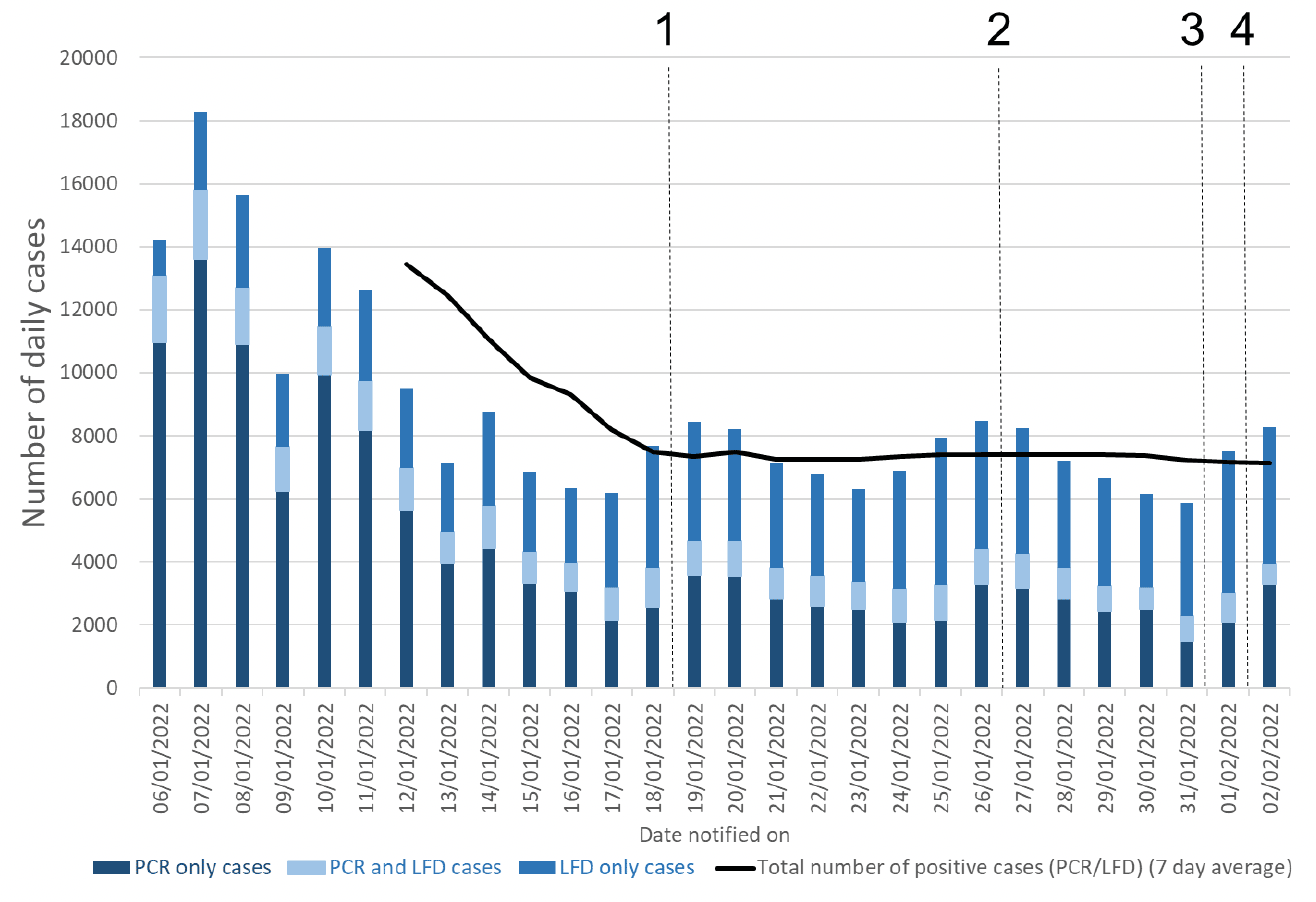
R, growth rate and incidence are as of 18th January 2022 (dashed line 1). The Scottish Contact Survey uses data to 26th January 2022 (dashed line 2). The Scottish Government modelling of infections, the long Covid analysis and the modelled rates of positive tests per 100K use data to 31st January (dashed line). The wastewater analysis uses data to 1st February 2022 (dashed line 4).
Overview of Scottish Government Modelling
Modelling outputs are provided here on the current epidemic in Scotland as a whole, based on a range of methods. Because it takes a little over three weeks on average for a person who catches Covid-19 to show symptoms, become sick, and either die or recover, there is a time lag in what our model can tell us about any change in the epidemic.
This week the Scottish Government presented one output to EMRG.
This used modelled infection figures provided by the Covid Infection Survey. This output is included in Figures 2 and 3.
The R value and growth rates are estimated by several independent modelling groups based in universities and the UKHSA. Estimates are considered, discussed and combined at the Epidemiology Modelling Review Group (EMRG), which sits within the UKHSA. These are based on data to 31st January.
UKHSA's consensus view across these methods was that the value of R in Scotland[3] is between 0.6 and 0.9, as of 18th January 2022[4] (Figure 2). R is an indicator that lags by two to three weeks.
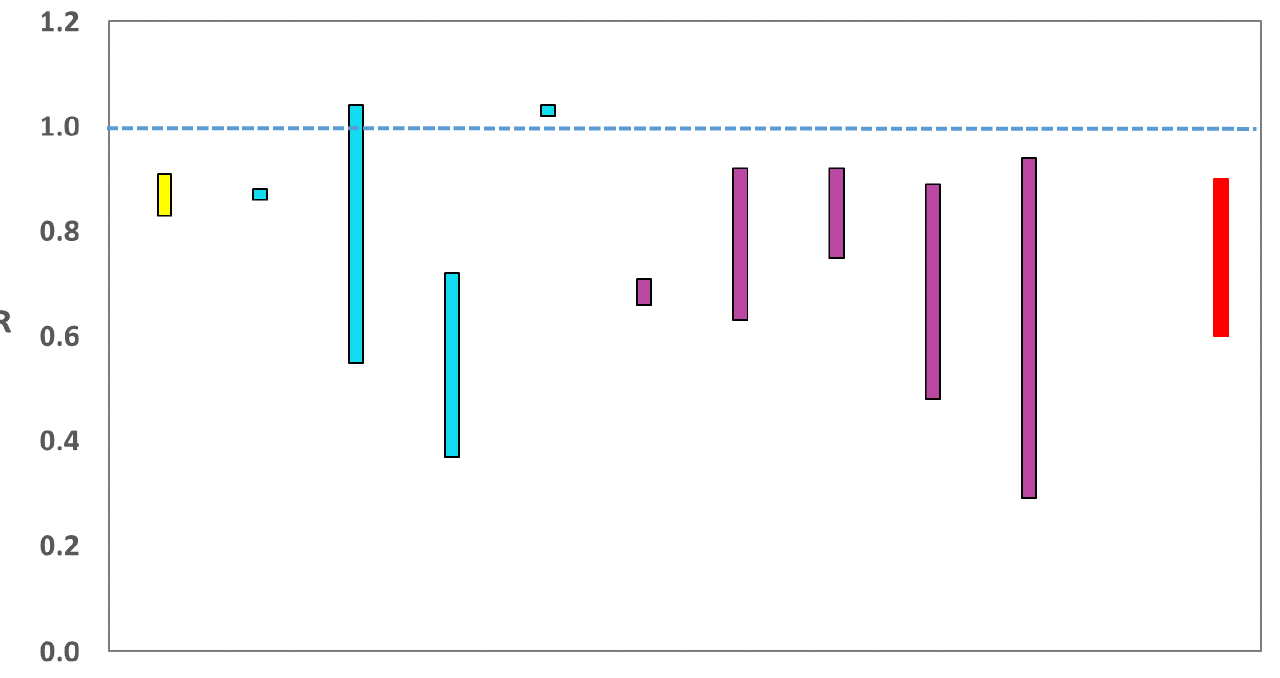
Source: EMRG
The various groups which report to the EMRG use different sources of data in their models to produce estimates of incidence (Figure 3). UKHSA's consensus view across these methods, as at 18th January, was that the incidence of new daily infections in Scotland was between 146 and 270 new infections per 100,000. This equates to between 8,000 and 14,800 people becoming infected each day in Scotland.
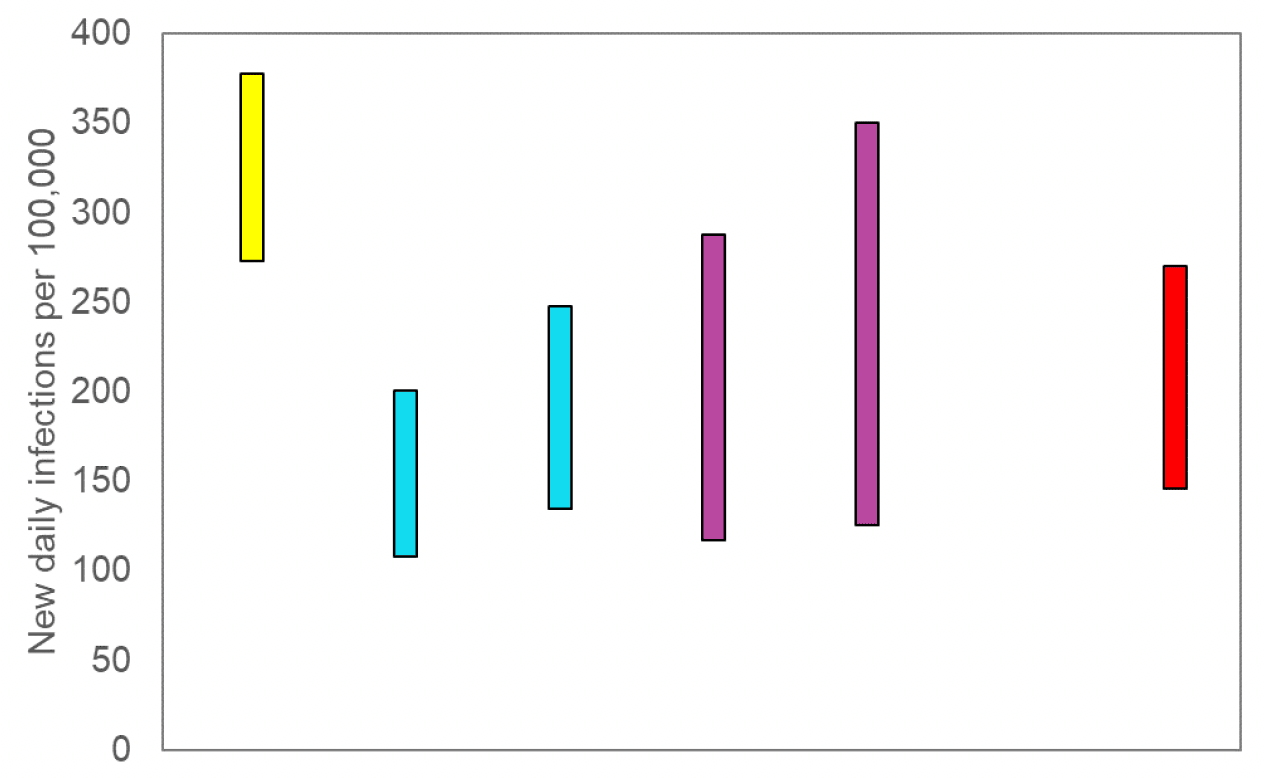
Source: EMRG
The consensus from UKHSA for this week is that the growth rate in Scotland is between -8% and -1% per day as at 18th January. The upper limit has increased since last week.
What we know about how people's contact patterns have changed
Average contacts from the most recent Panel A cohort of the Scottish Contact Survey (week ending 26th January) indicate an average of 4.7 contacts following the recent decrease over the festive period. This has increased by 13% compared to the previous Panel A of the survey (week ending 12th January), as seen in Figure 4. Mean contacts have increased within the work and other setting (contacts outside home, school and work) by 45% and 13% respectively in the last two weeks. Contacts within the home have remained at a similar level over the same period.
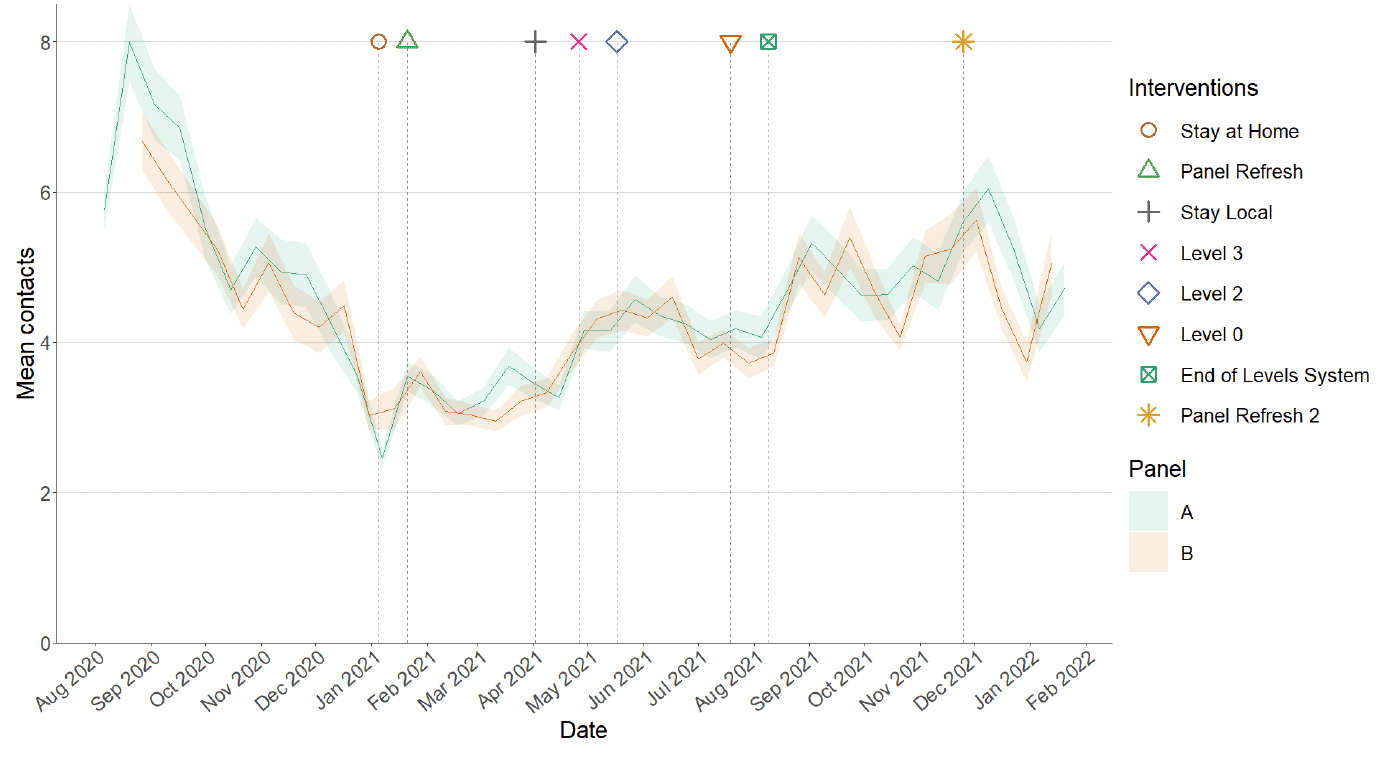
Figure 5 shows how contacts change across age group and setting. All age groups with the exception of those in the 30-39 age group reported an increase in contacts in the last two weeks. Increases were largely driven by contacts within the work setting for those under 70, with individuals 70 and over reporting a rise in contacts within the other setting.
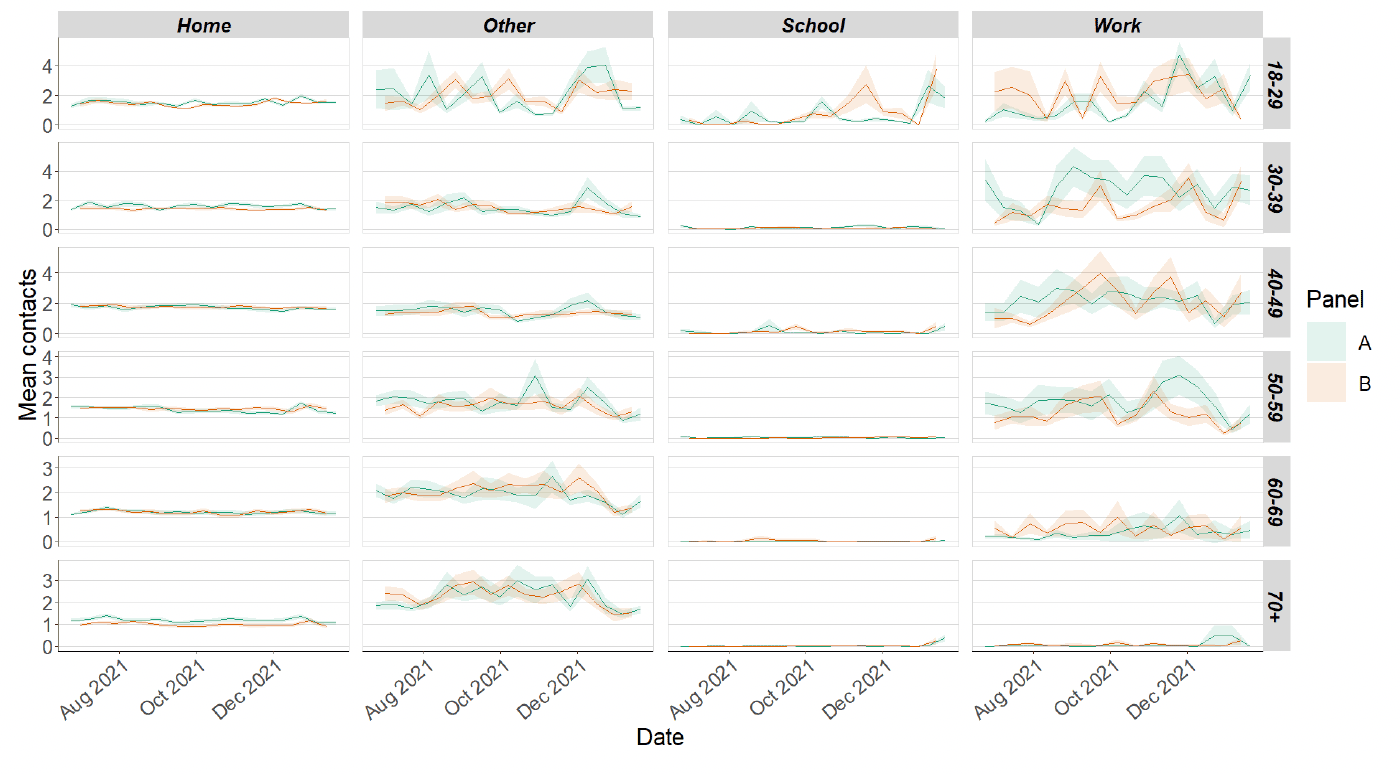
The heatmaps in Figure 6 show the mean overall contacts between age groups for the weeks relating to 6th January - 12th January and 20th January - 26th January and the difference between these periods. The biggest increase in interactions between age groups is between those aged 18-29 with each other, where interactions are close to two times higher in comparison to two weeks prior.
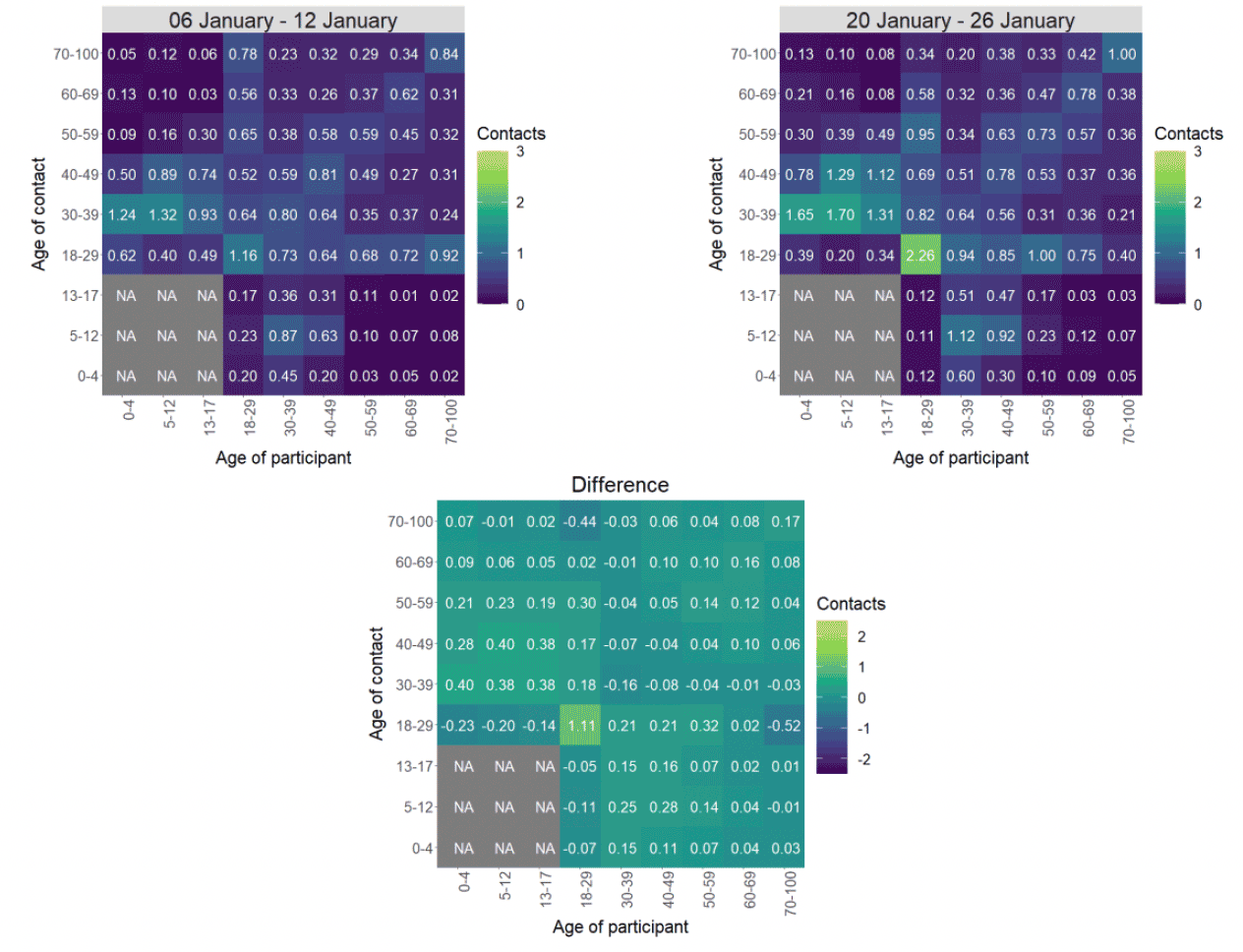
The biggest differences in the proportion of participants visiting different locations is seen in those visiting another's home and visiting a healthcare facility. Visits to another's home reported the biggest decrease, from approximately 47% to 43% while visits to a healthcare facility reported the largest increase, from 12% to 21% in the last two weeks as shown in Figure 7.
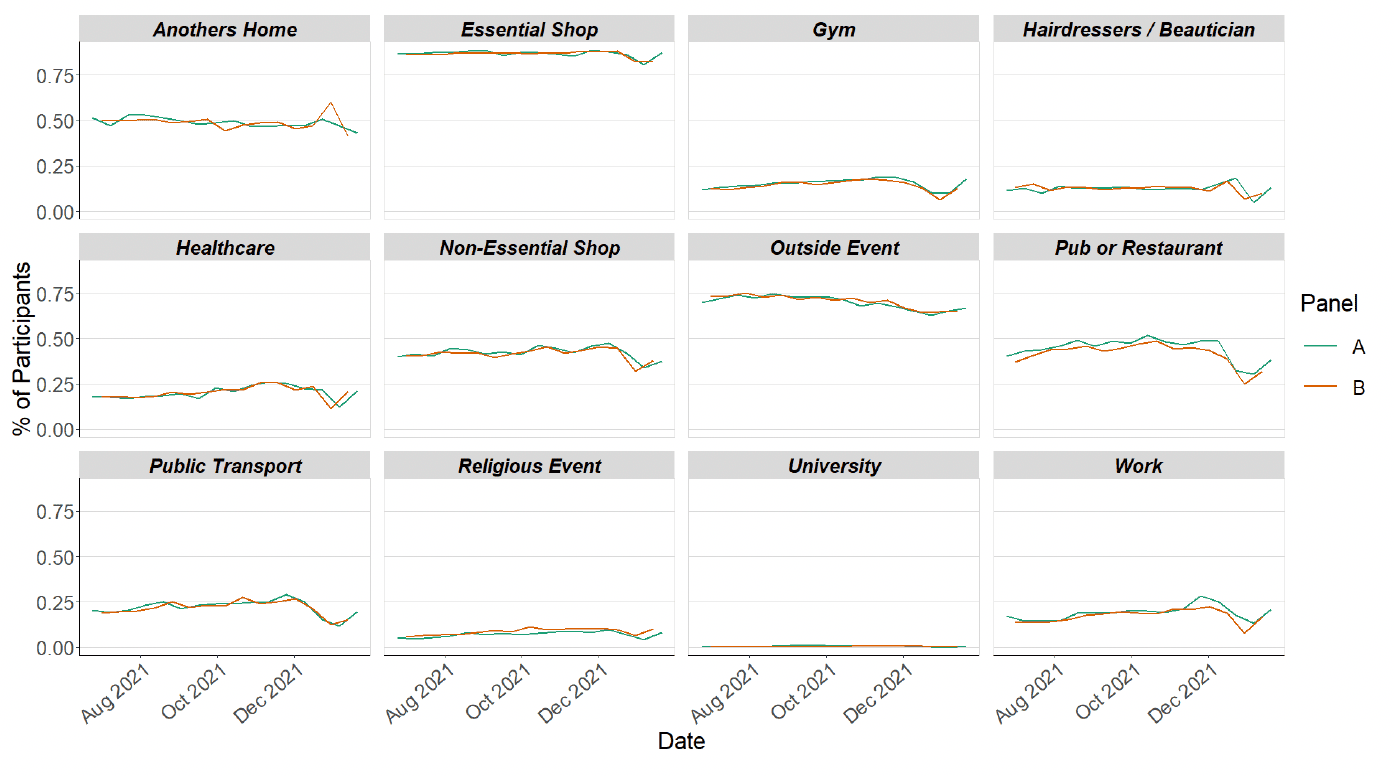
Figure 8 shows the number of people wearing a face covering where they have at least one contact outside of the home. This has increased in the last two weeks from 75% to 81%.
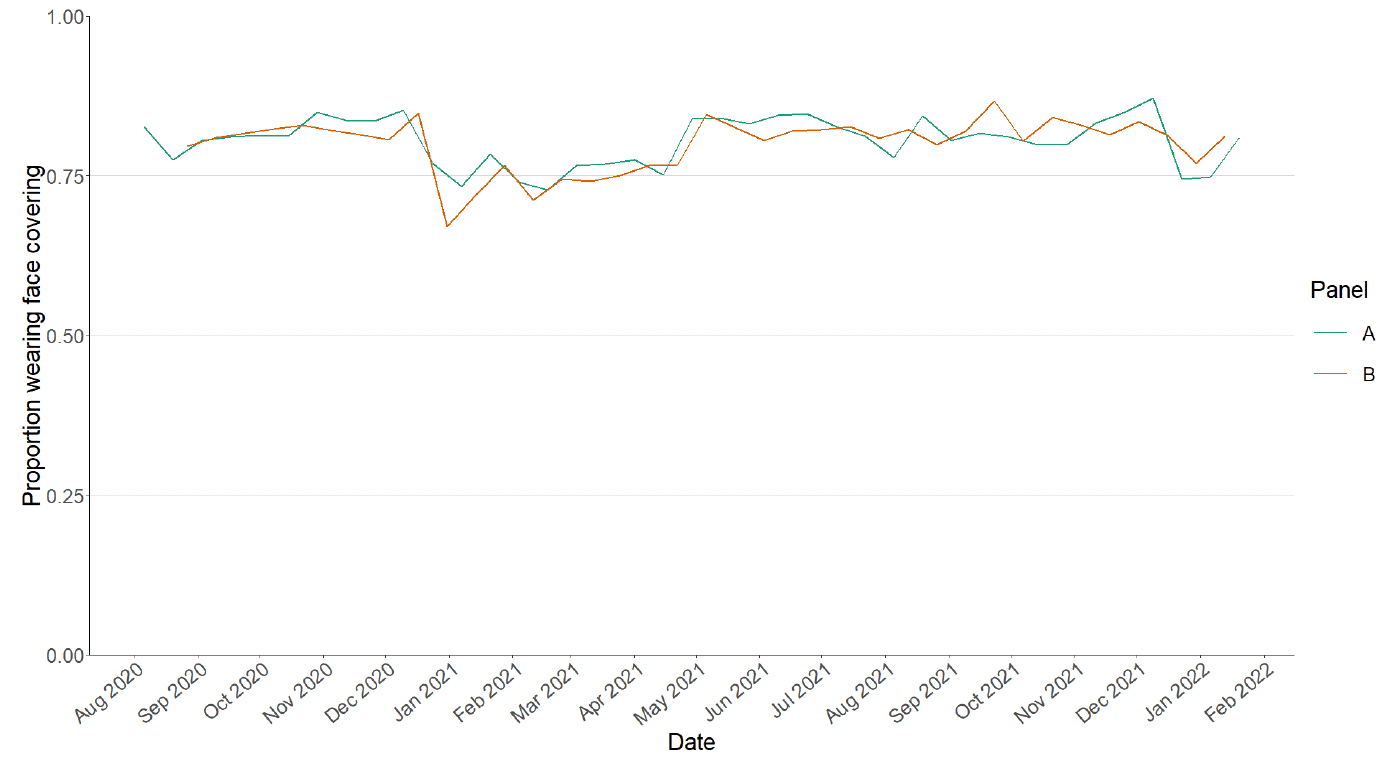
Approximately 78% of individuals had taken at least one lateral flow test within the last 7 days for the survey pertaining to the 20th - 26th January, decreasing from 84% two weeks prior as shown in Figure 9.
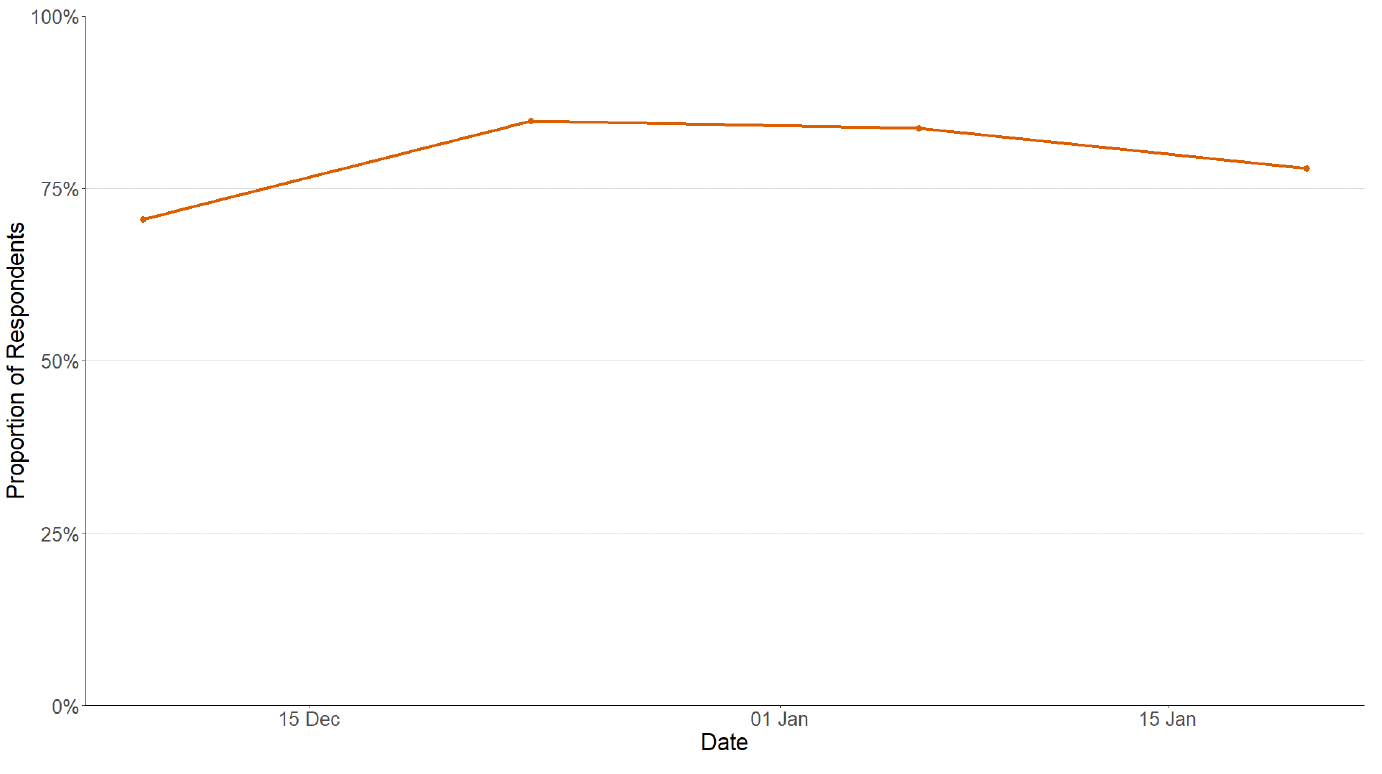
Of those individuals who had taken a lateral flow within the last 7 days, 27% did not report their results as shown in Figure 10.
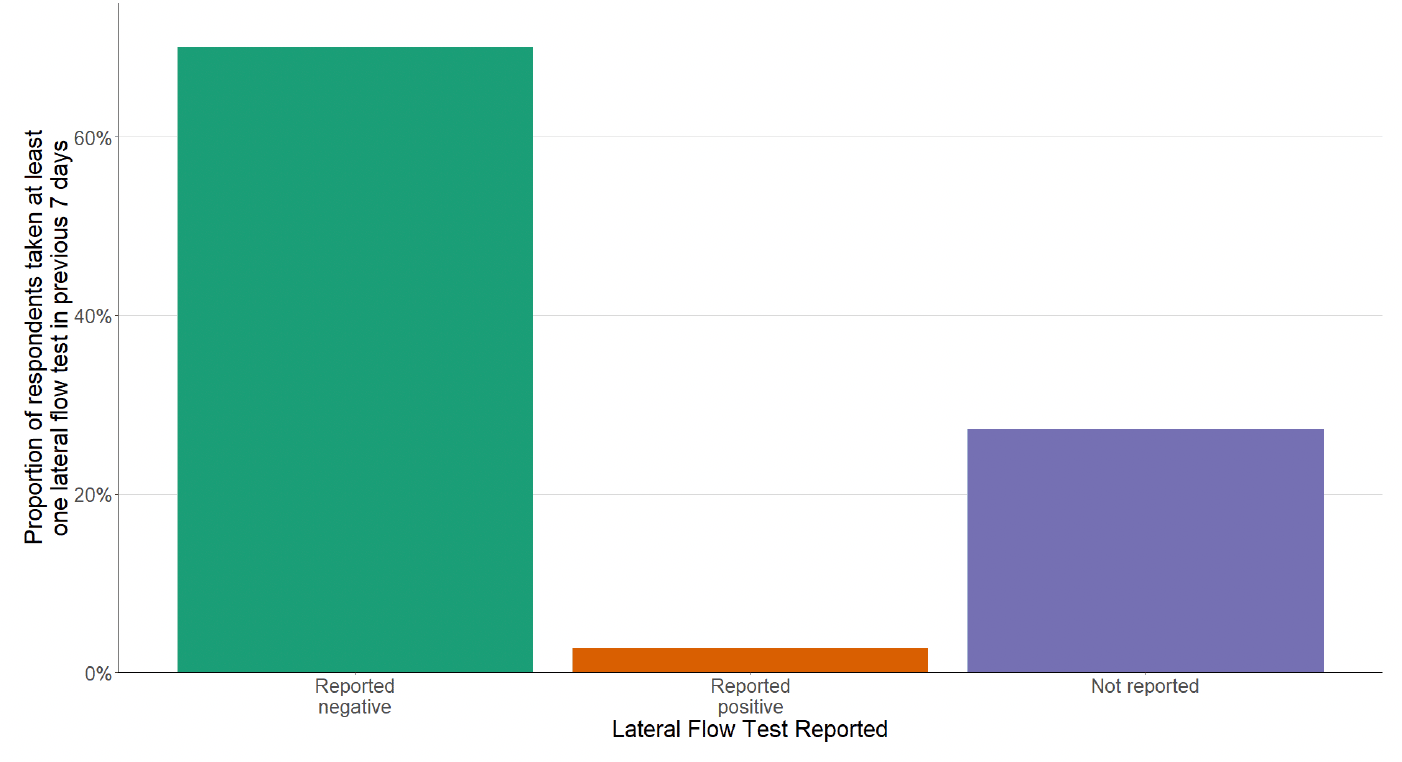
What the modelling tells us about estimated infections
The Scottish Government assesses the impact of Covid-19 on the NHS in the next few weeks. Figures 11 - 13 show projections over the four weeks for combined Delta and Omicron infections.
These projections include the effect of the interventions announced on 14th and 21st December 2021; those announced as being lifted from 17th, 24th and 31st January 2022; and booster take up. 'Central' assumes that infections broadly plateau at current levels. 'Worse' assumes a higher transmissibility for Covid-19 whereas 'Better' assumes a lower transmissibility. All projections also assume a lower vaccine effectiveness for Omicron than for Delta[6].
The future trajectory of infections is uncertain.
Following the announcement removing the need for a confirmatory PCR test in some cases we have used combined PCR and LFD reported date data from 6th January.
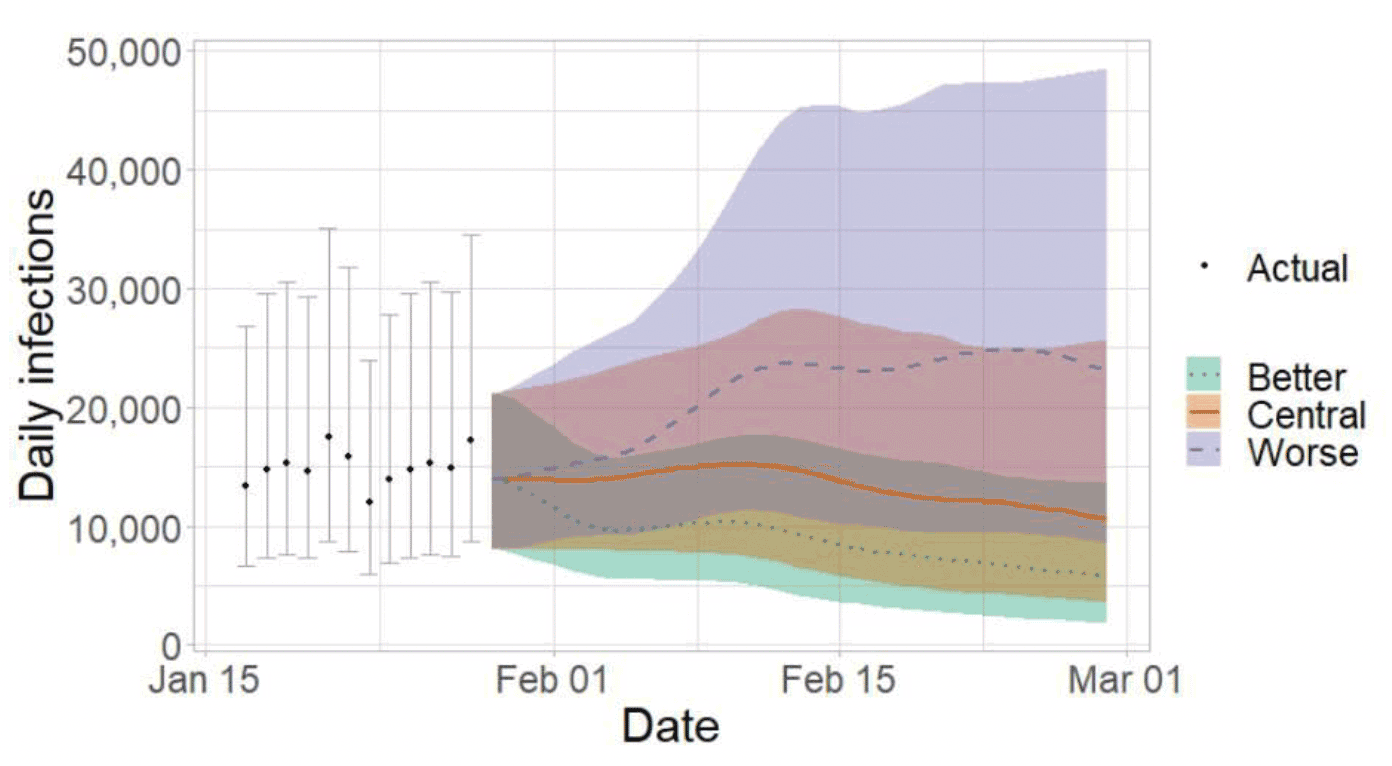
We estimate that daily infections may be between 5,000 and 50,000 at the start of March.
Figure 12 shows the impact of the projections on the number of people in hospital. The modelling includes all hospital stays, whereas the actuals only include stays up to 28 days duration that are linked to Covid-19.
There continues to be uncertainty over hospital occupancy and intensive care in the next four weeks.
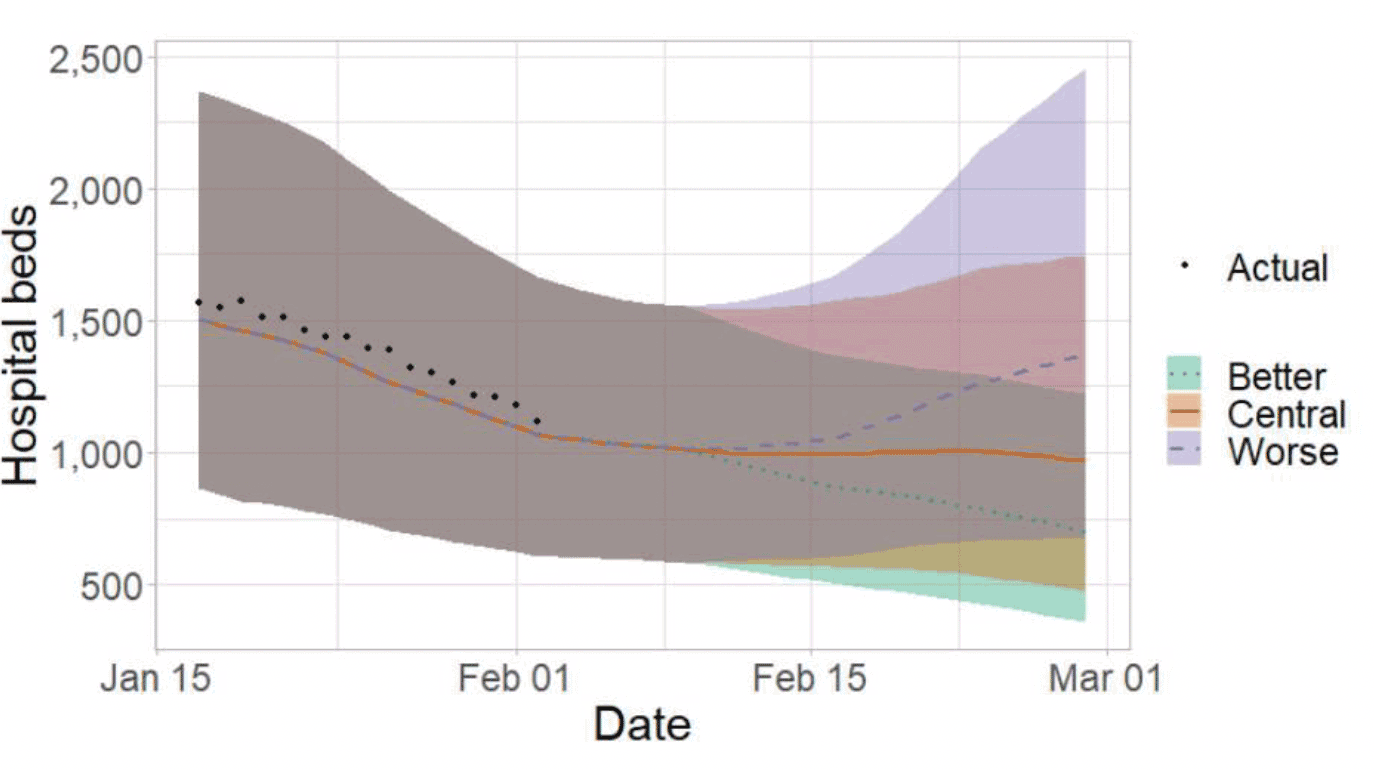
Figure 13 shows the impact of the projection on ICU bed demand.
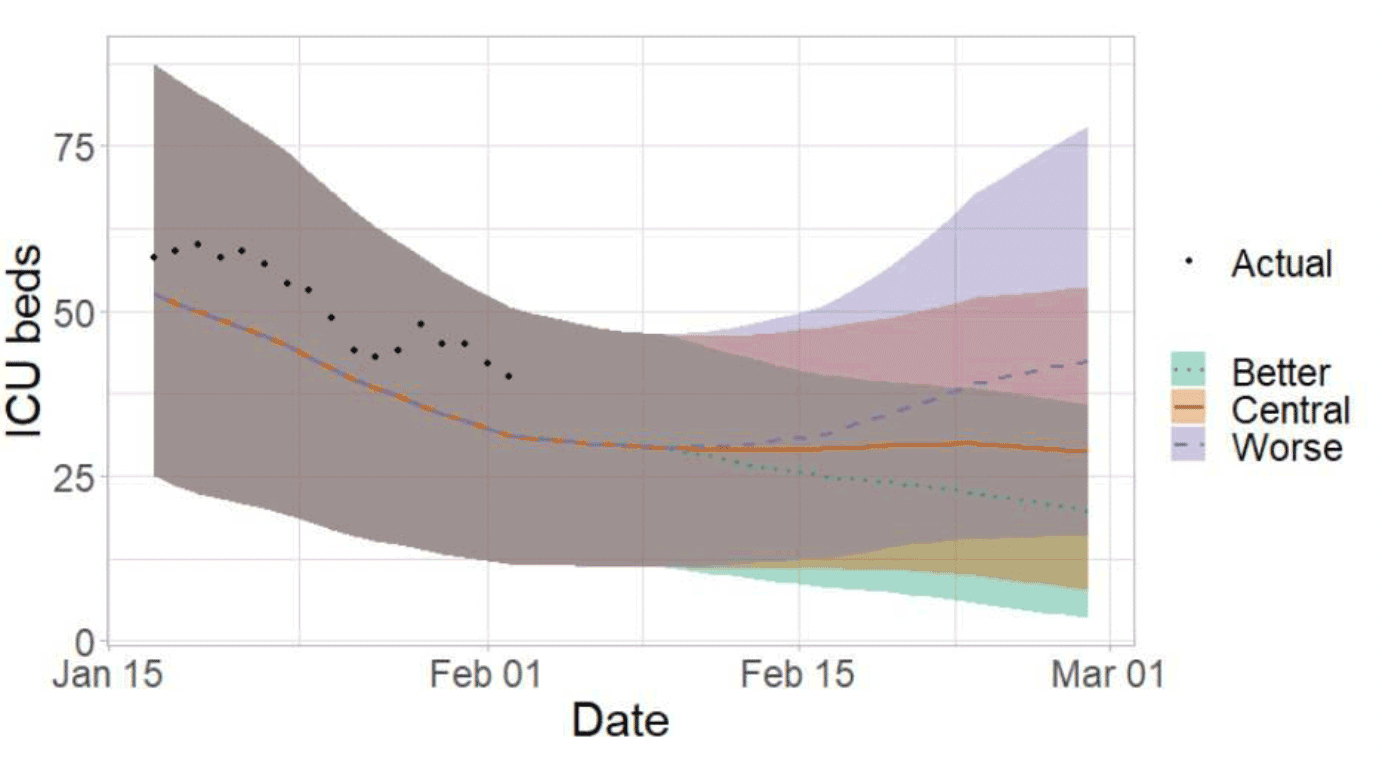
What the modelling tells us about projections of hospitalisations, occupancy and deaths in the medium term
SPI-M-O produces projections of the epidemic (Figures 14 - 16), combining estimates from several independent models. These projections are not forecasts or predictions. They represent a scenario in which the trajectory of the epidemic continues to follow the trends that were seen in the data available to 31st January and do not include the effects of any future policy or behavioural changes.
The delay between infection, developing symptoms, the need for hospital care, and death means they cannot fully reflect the impact of behaviour changes in the two to three weeks prior to 31st January.
The projections include the potential impact of vaccinations over the next few weeks. Modelling groups have used their expert judgement and evidence from UKHSA, Scottish Universities & Public Health Scotland, and other published efficacy studies when making assumptions about vaccine effectiveness.
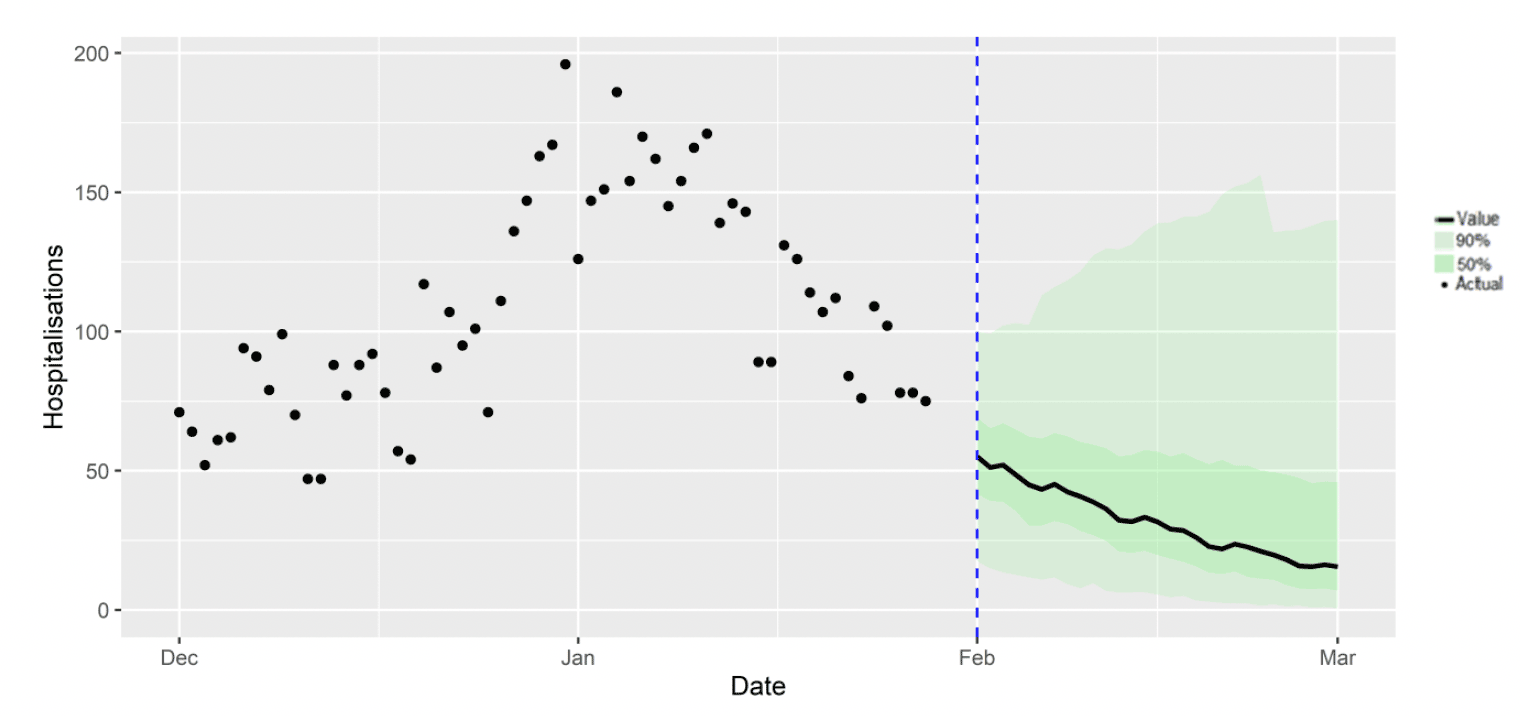
Figure 15 shows the SPI-M-O consensus on hospital occupancy. Hospital occupancy is determined by the combination of admissions and length of stay (LoS), the latter of which is difficult to model with confidence.
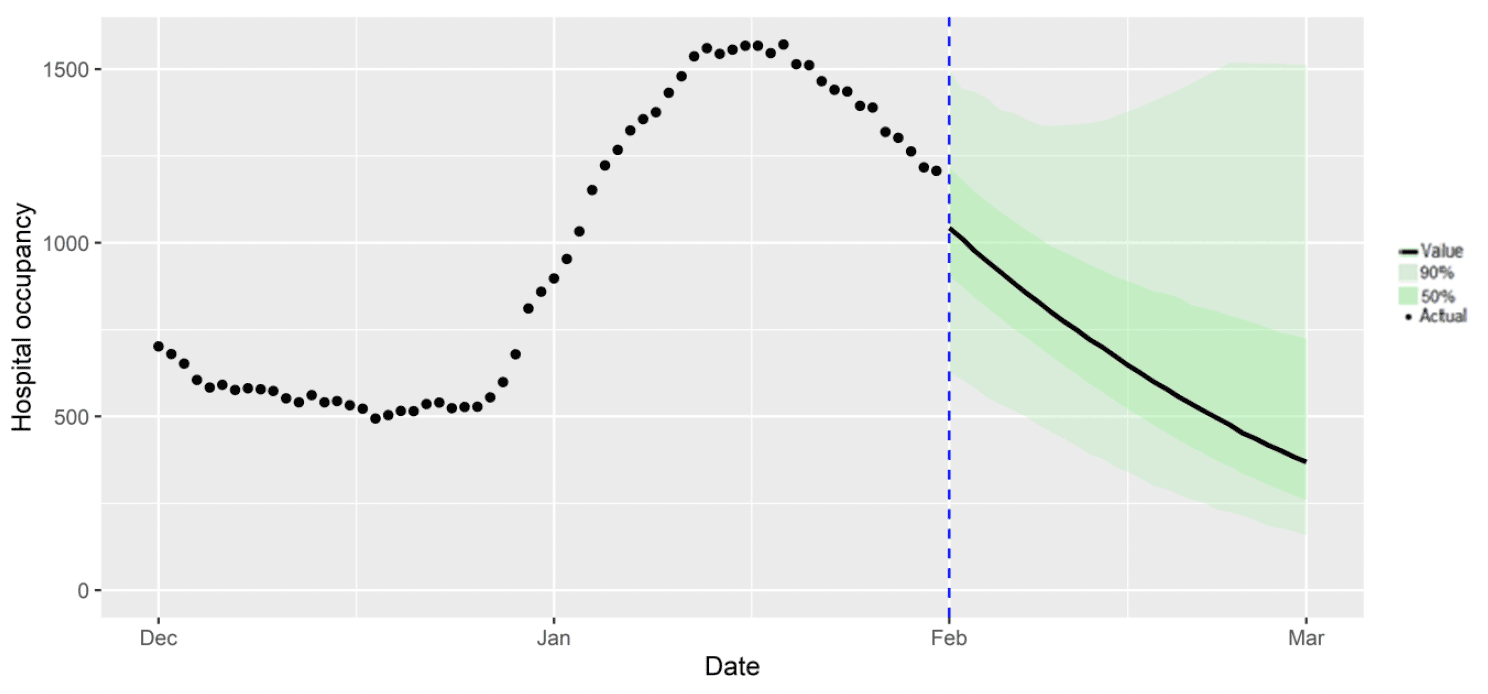
Figure 16 shows the SPI-M-O consensus on daily Covid-19 deaths.
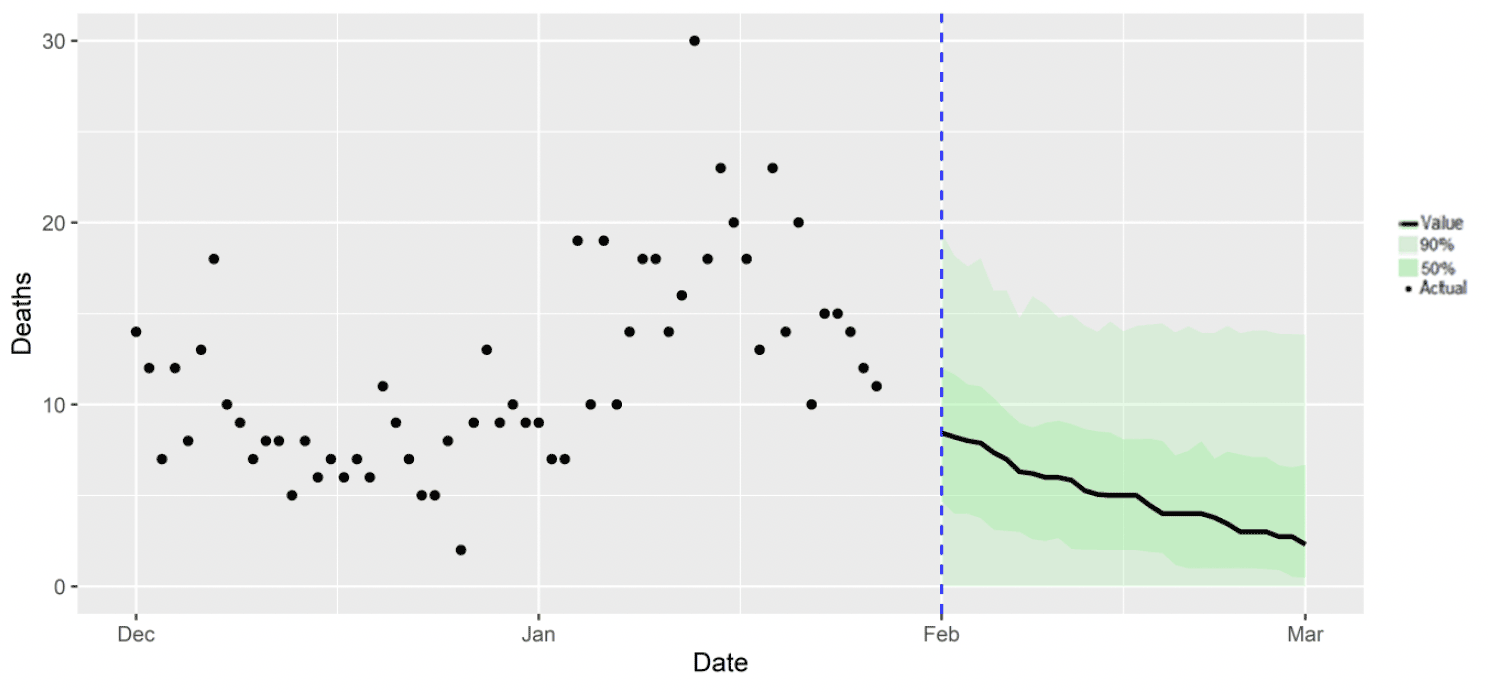
What we know about which local authorities are likely to experience high levels of Covid-19 in two weeks' time
We continue to use modelling based on Covid-19 cases and deaths using data to 31st January 2022 from several academic groups to give us an indication of whether a local authority is likely to experience elevated levels of Covid-19 in the future. This has been compiled via UKHSA into a consensus. In this an area is defined as a hotspot if the two-week prediction of cases (positive tests) per 100K population is predicted to exceed a threshold, e.g., 500 cases.
In less populated regions in which case numbers are small, there is a greater variation in model estimates, and hence increased uncertainty.
This has led to one model not being included in the combination for Na h-Eileanan Siar, Orkney Islands and Shetland Islands.
Some of the models contributing to this analysis are informed by both PCR and LFD positive tests whilst others are currently informed by PCR only.
Modelled rates of positive tests per 100K using data to 31st January (Figure 17) indicate that, for the week commencing 13th February 2022, 29 of the 32 local authorities are expected to exceed 50 cases per 100K with at least 75% probability. The exceptions are Na h-Eileanan Siar, Orkney Islands and Shetland Islands.
28 local authorities are expected to exceed 100 cases per 100K, with at least 75% probability. The exceptions are Moray, Na h-Eileanan Siar, Orkney Islands and Shetland Islands.
No local authorities are expected to exceed 300 cases per 100K, with at least 75% probability.
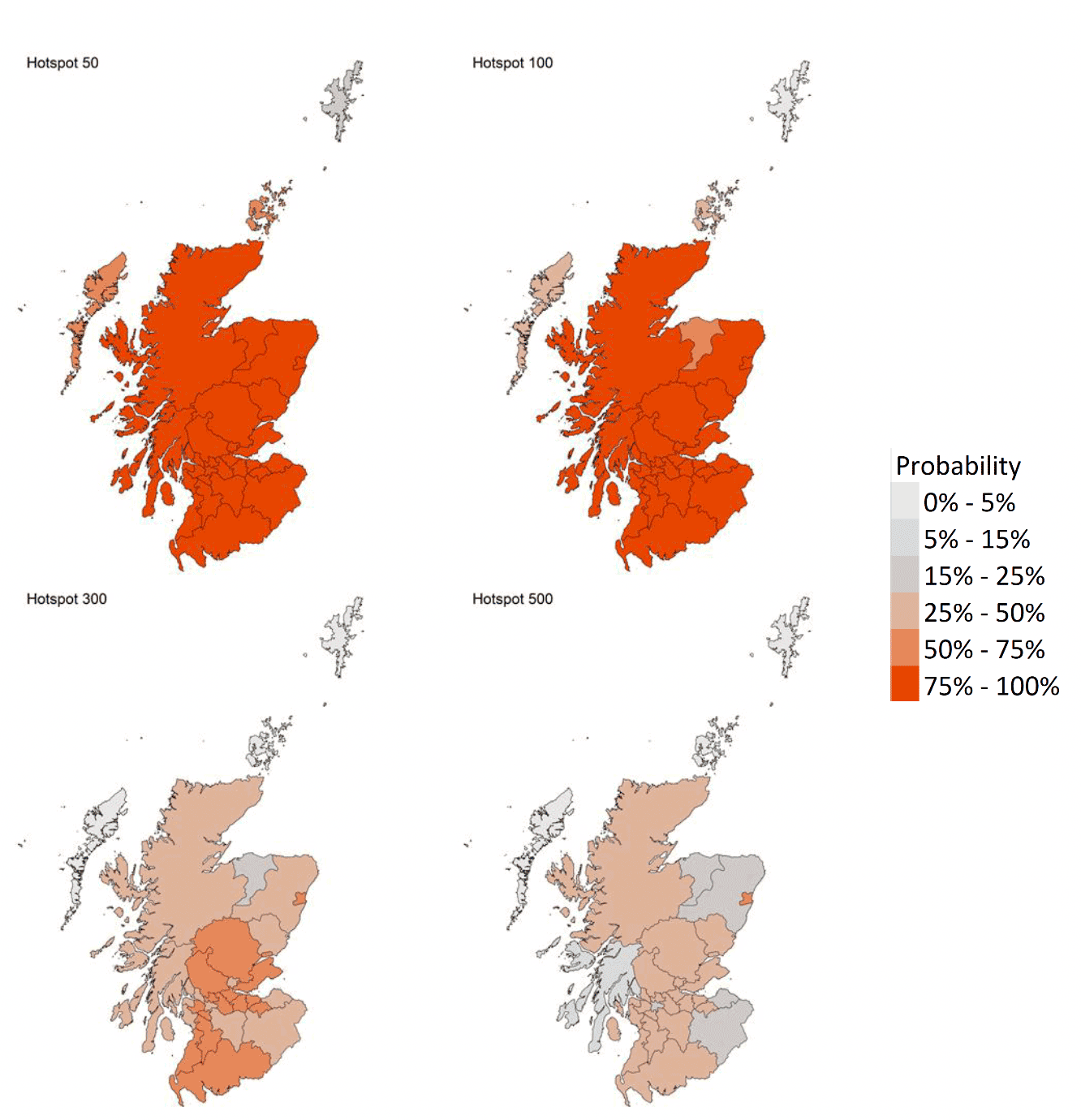
What can analysis of wastewater samples tell us about local outbreaks of Covid-19 infection?
Levels of Covid-19 RNA in wastewater (WW) collected at a number of sites around Scotland are adjusted for population and local changes in intake flow rate (or ammonia levels where flow is not available). See Technical Annex in Issue 34 of these Research Findings for the methodology.
Nationwide, wastewater Covid-19 levels have stopped falling, with the week ending on 1st February recording levels of 56 million gene copies per person per day (Mgc/p/d), matching 57 Mgc/p/d the previous week (week ending 25th January). There may also be early indication of viral levels showing a slight increase in some areas of the country.
Compared to before December 2021, WW Covid-19 levels appear lower than anticipated given the known levels of Covid-19 activity. This effect may be due to the switchover from Delta variants to the new Omicron variant. Thus, Figure 18 shows only data from after the end of 2021, at which point the Omicron variant already represents almost all cases in Scotland. From this, we see a rapid decline from peak levels in early January with a continued albeit slower decline up to the start of February.
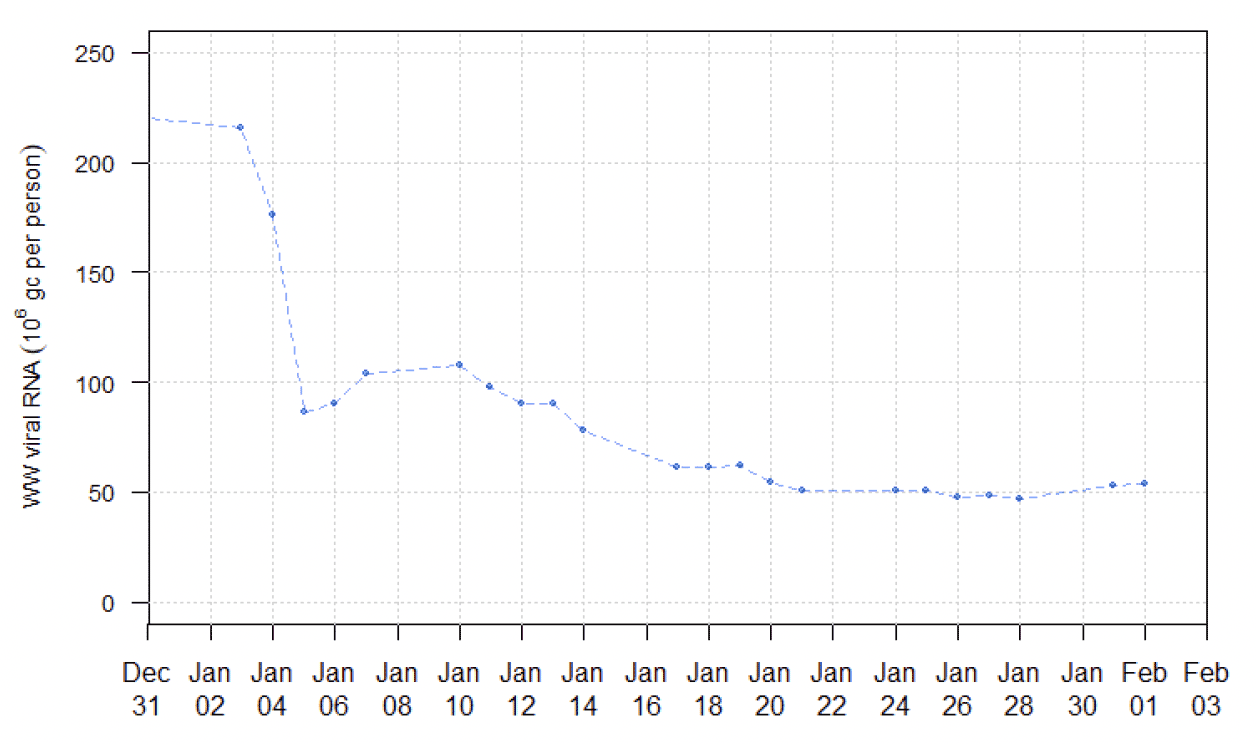
Figure 19 shows stable viral levels across most of the regions in Scotland. In some areas, most recent data points show an indication of a slight increase in both wastewater viral levels and case rates, for example in Aberdeen City (pop: 227 k) or the Orkney Islands (pop: 23 k). However, changes in PCR testing strategy are thought to have impacted statistics relating to the rate of new cases.
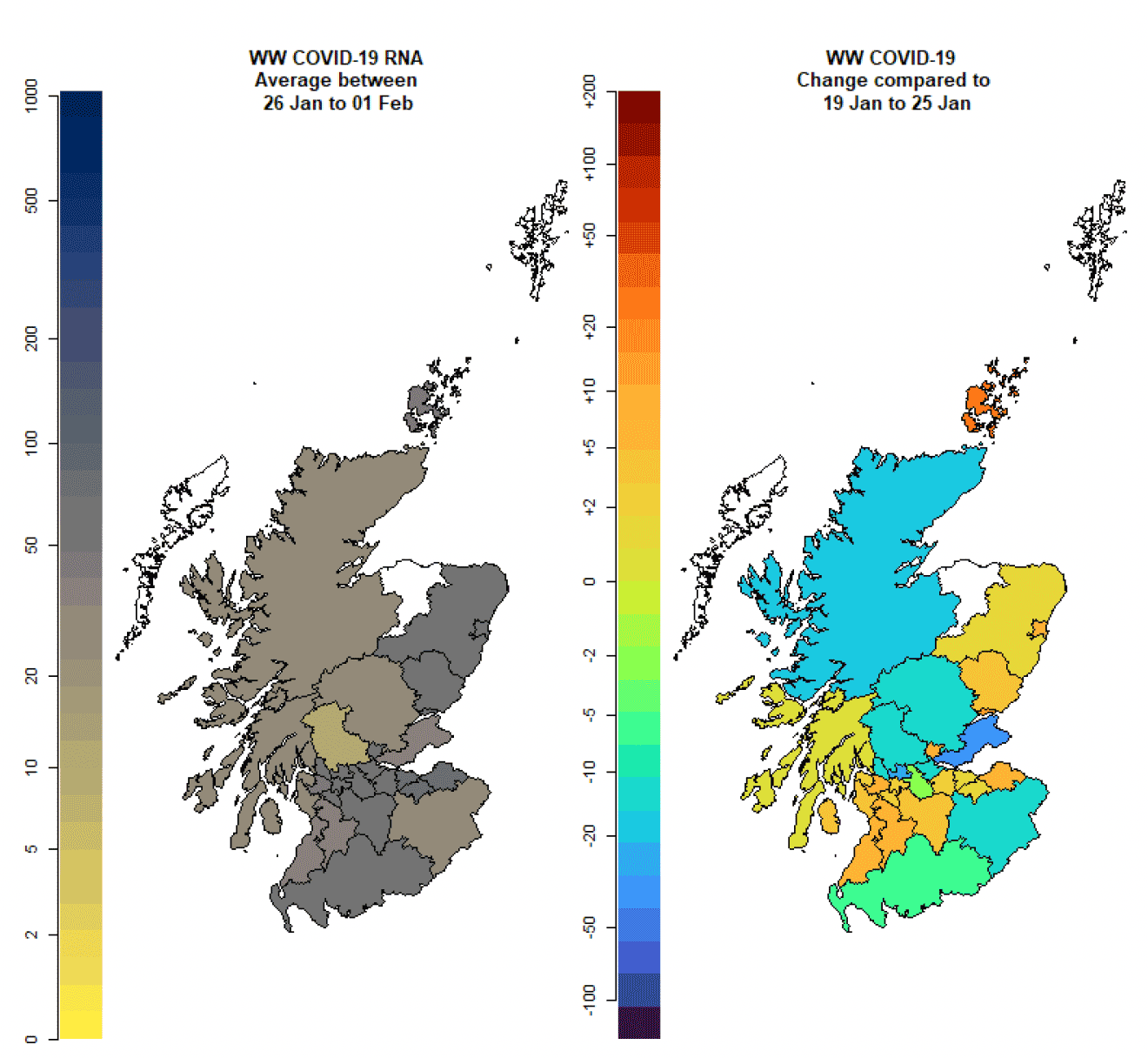
What estimates do we have of the number of people experiencing long Covid symptoms?
The Scottish Government is modelling the number of people likely to experience long Covid symptoms. This gives a projection of estimated self-reported long Covid rates in the future, based on Scottish Government medium term projection modelling, as set out in Figure 20.
This modelling estimates that at 20th February 2022 between 61,000 (1.1% of the population) and 161,000 (2.9%) people are projected to self-classify with long Covid for 12 weeks or more after their first suspected Covid infection in Scotland.
These are preliminary results, further data on rates of long Covid and associated syndromes as research emerges are required.
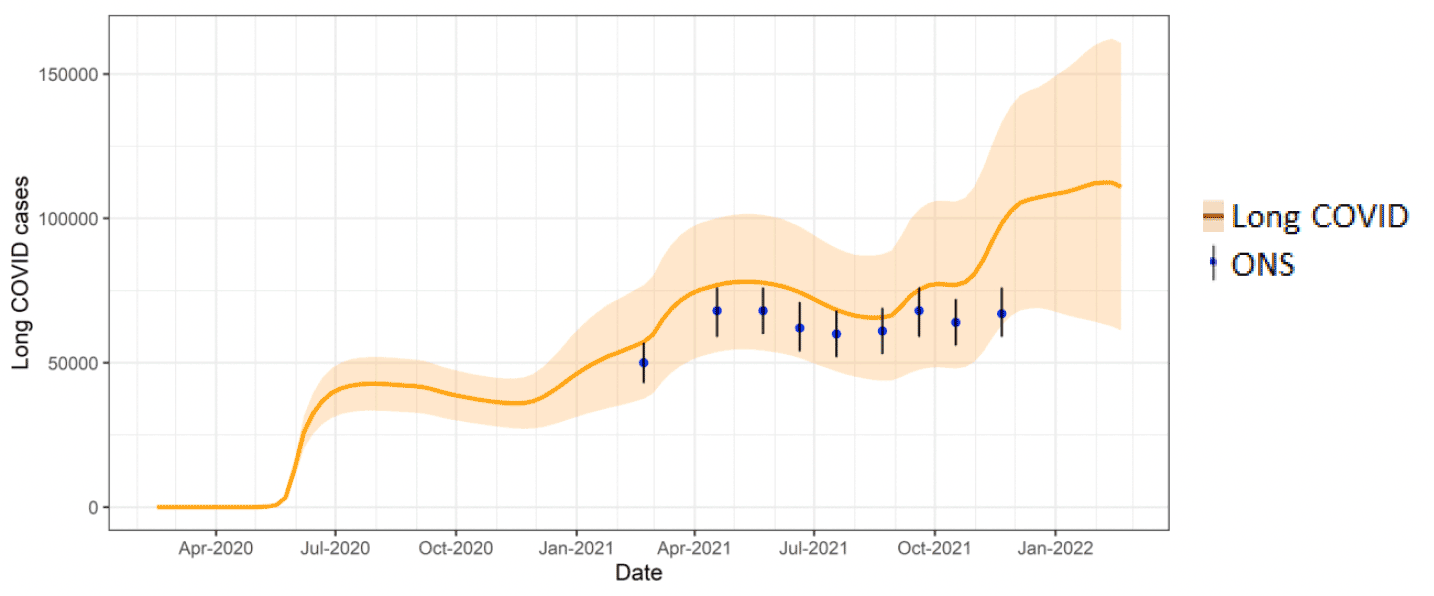
See the Technical Annex in issue 73 for information about the methodology.
What next?
Modelling will continue to look at the impacts of Omicron and residual Delta variants. As the year progresses we will incorporate different models as and when it is appropriate to do so.
Contact
There is a problem
Thanks for your feedback